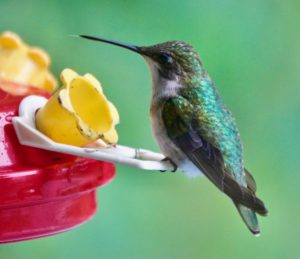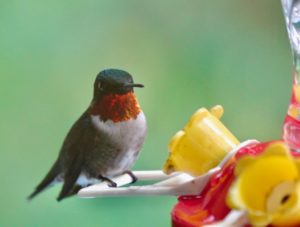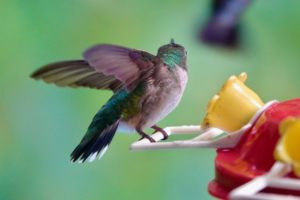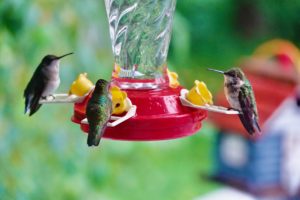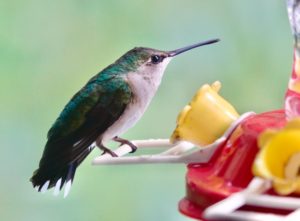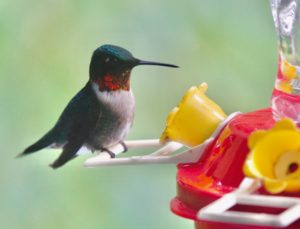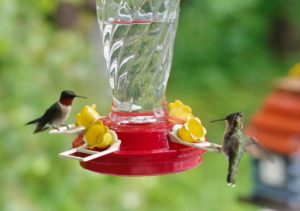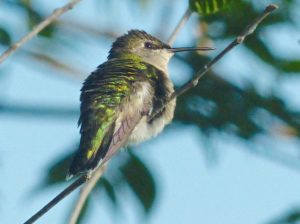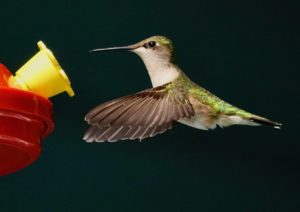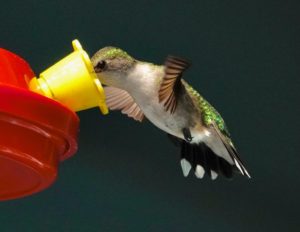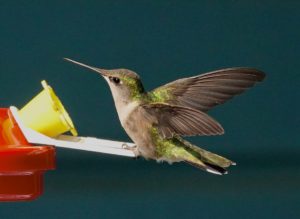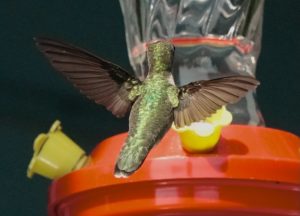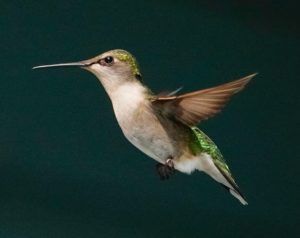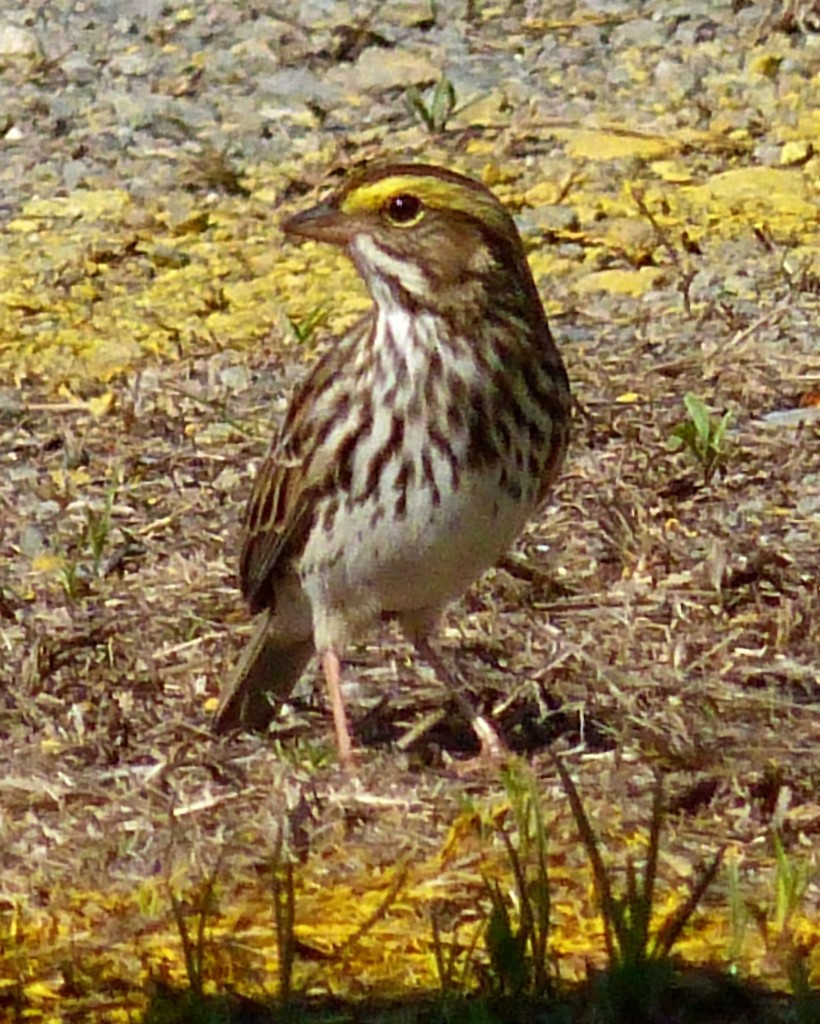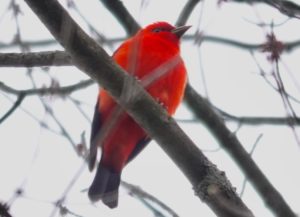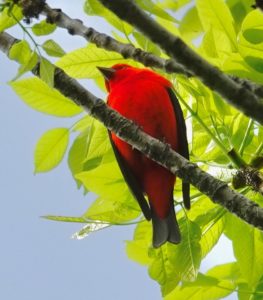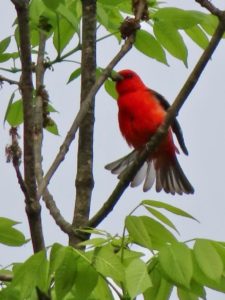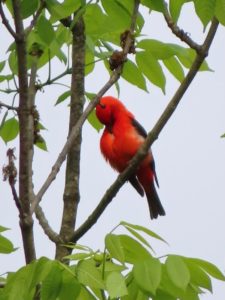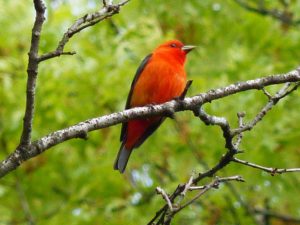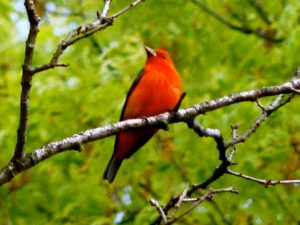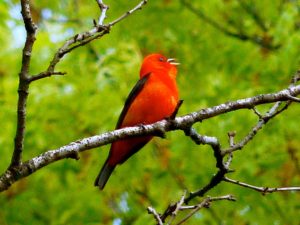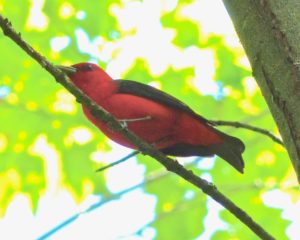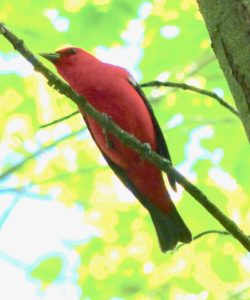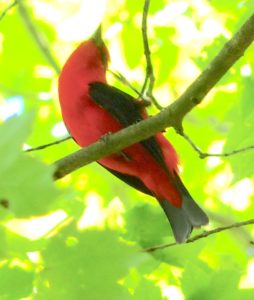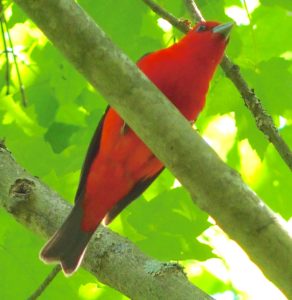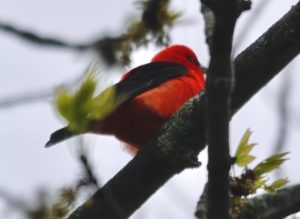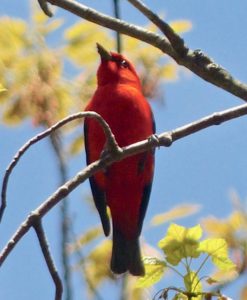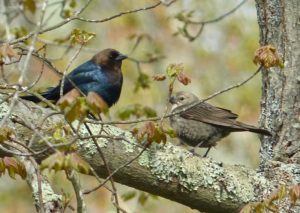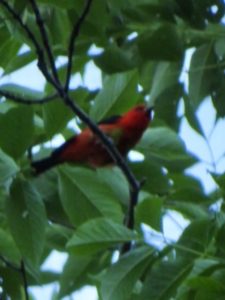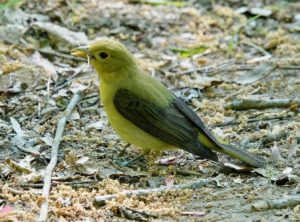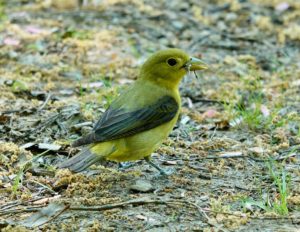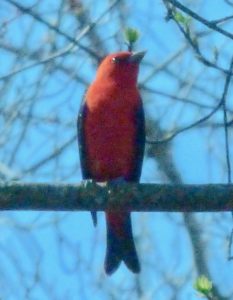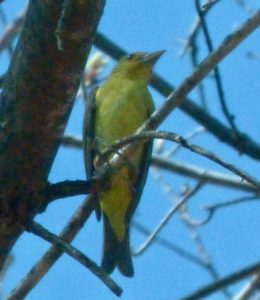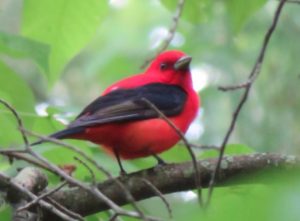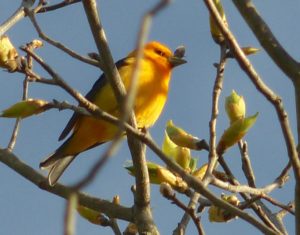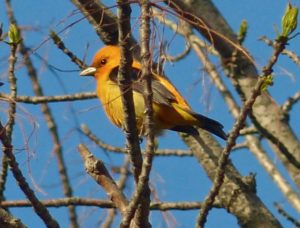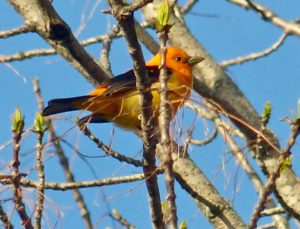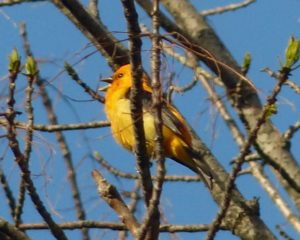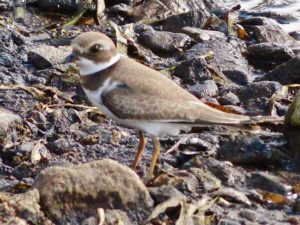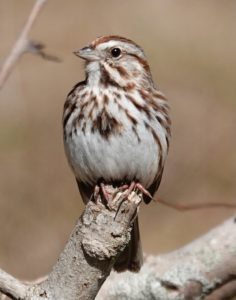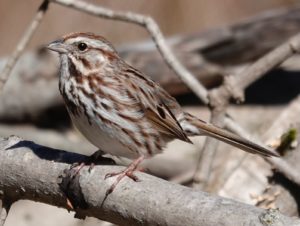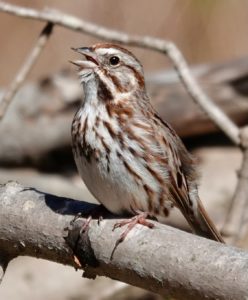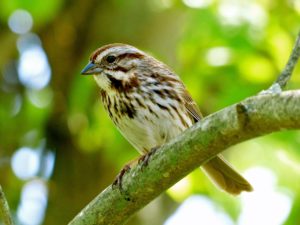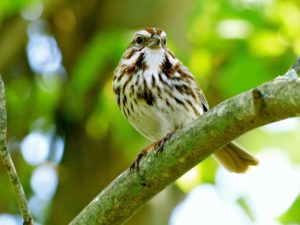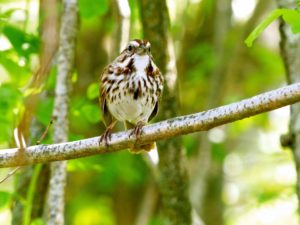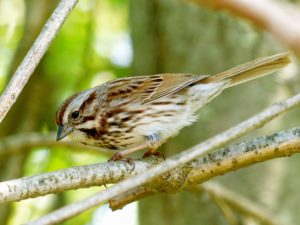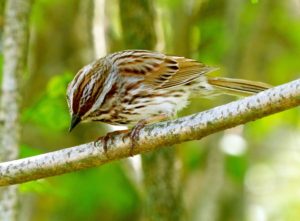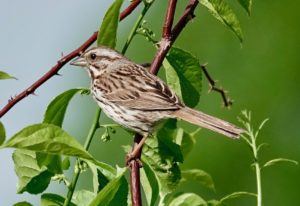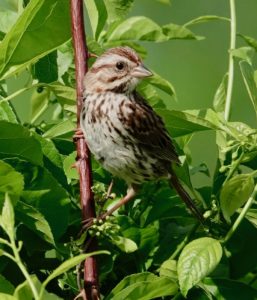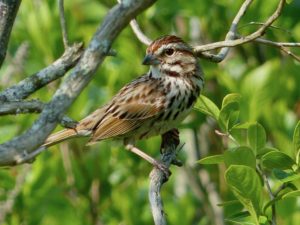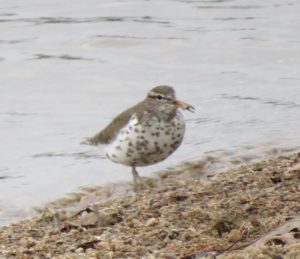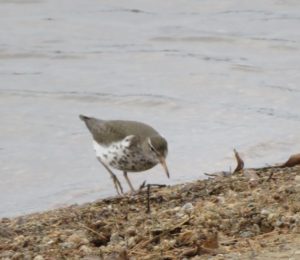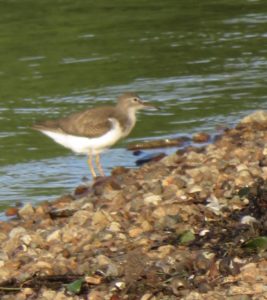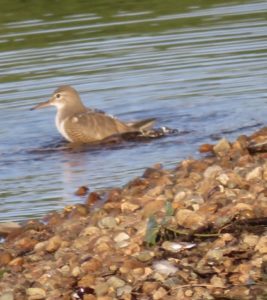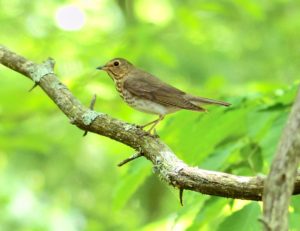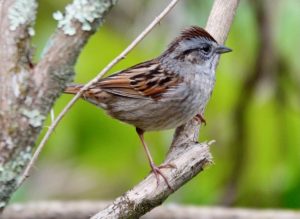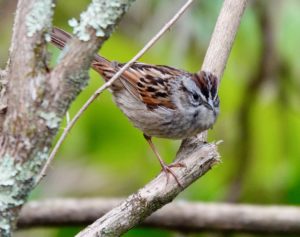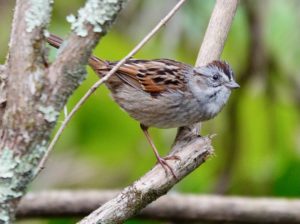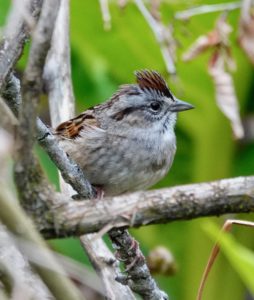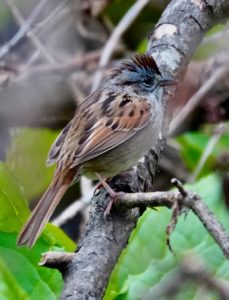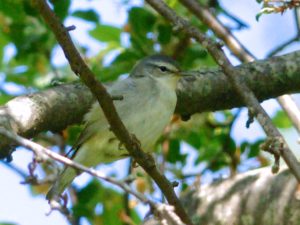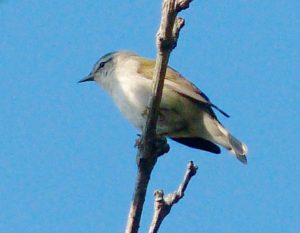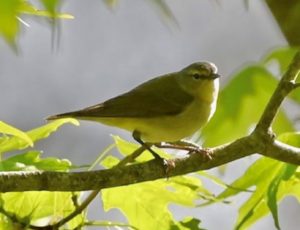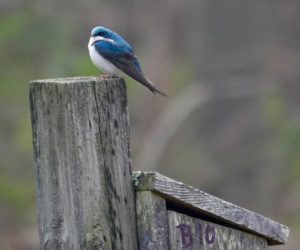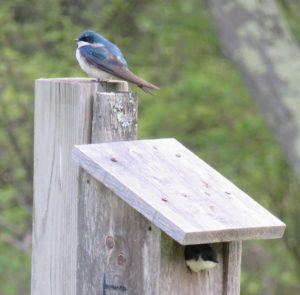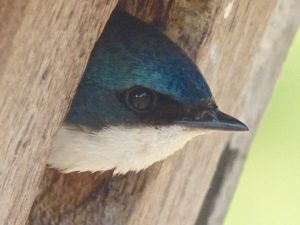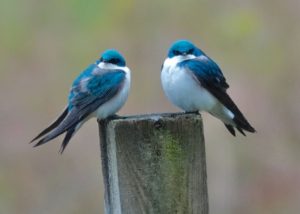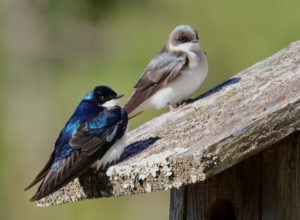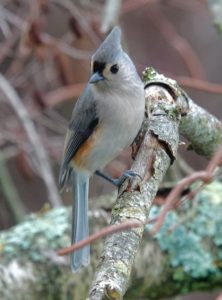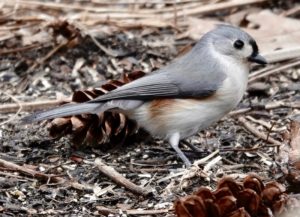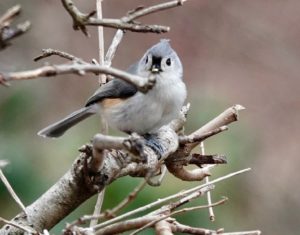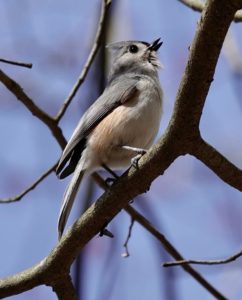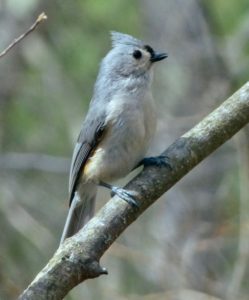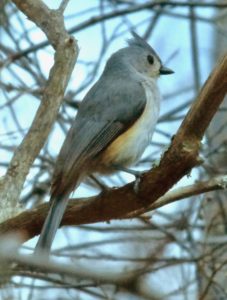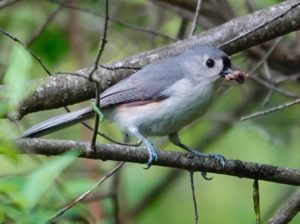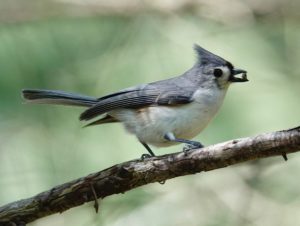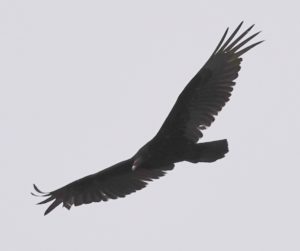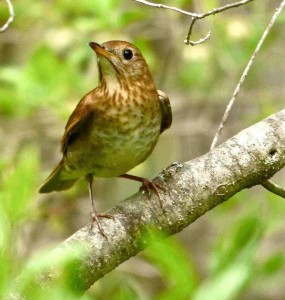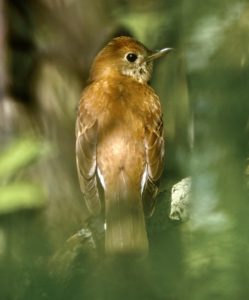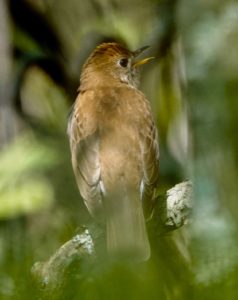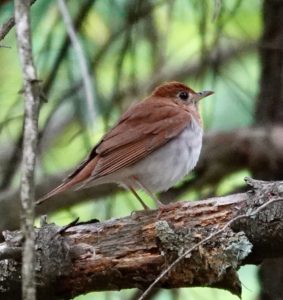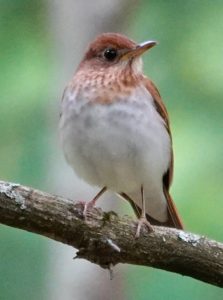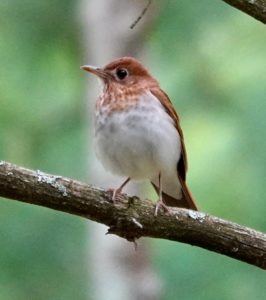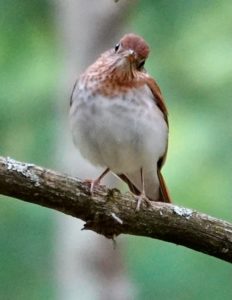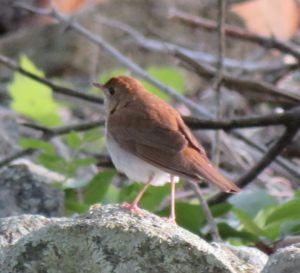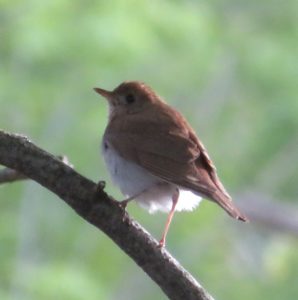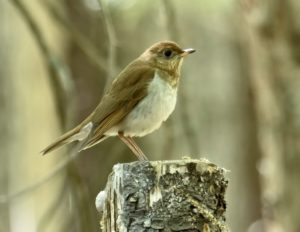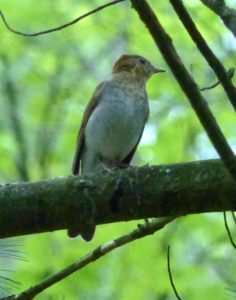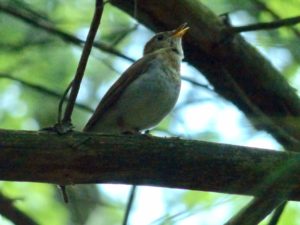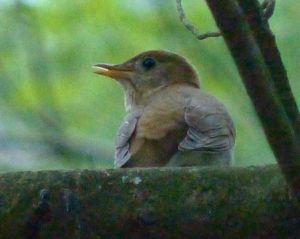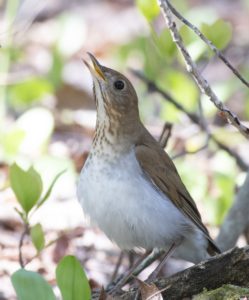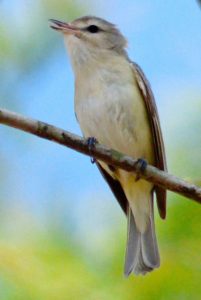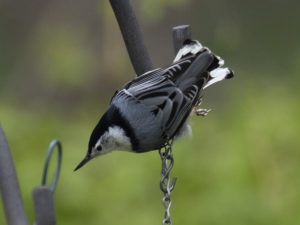Sightings – Birds
Observer: Josh Simons
Observation Date: 6/25/11
Observation Time: 1:00 p.m.
Observation Location: Moose Hill area
Common Name: Ruby-throated Hummingbird
Scientific Name: Archilochus colubris
Comments: Female (sticking out her long tongue, which is adapted to probing for nectar in flower blossoms)
More Information: All About Birds
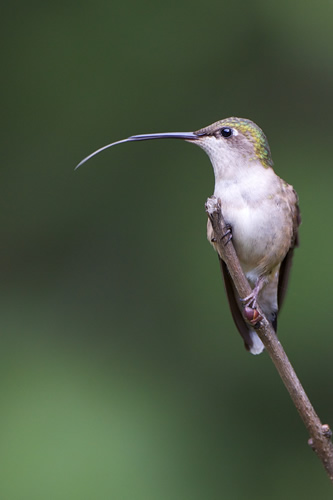
Observer: Paul Lauenstein
Observation Date: 7/3/21
Observation Time: 2:00 p.m.
Observation Location: 4 Gavins Pond Rd.
Common Name: Ruby-throated Hummingbird
Scientific Name: Archilochus colubris
Comments: Ruby-throated hummingbirds are the only species of hummingbird commonly seen in New England. They overwinter in Costa Rica. When they migrate north in spring, they fly several hundred miles across the Gulf of Mexico. They arrive in Massachusetts in late April. That’s a good time to put out a hummingbird feeder. If you’re lucky, and you change the sugar water in the feeder regularly, they’ll nest nearby and visit your feeder all summer. They make their nests out of lichens and spider webs. They weigh about as much as a nickel.
More Information: All About Birds
Observer: Paul Lauenstein
Observation Date: 5/21/16
Observation Time: 7:10 a.m.
Observation Location: Moose Hill Farm (The Trustees of Reservations)
Common Name: Ruby-throated Hummingbird
Scientific Name: Archilochus colubris
Comments: Ruby-throated hummingbirds are the only species of hummingbird commonly seen in New England. They overwinter in Costa Rica, and arrive in Massachusetts around May 1 every year. That’s a good time to put out a hummingbird feeder. If you’re lucky, and you change the sugar water in the feeder regularly, they’ll nest nearby and visit your feeder all summer.
More Information: All About Birds
Observer: Paul Lauenstein
Observation Date: 6/11/23
Observation Time: 9:40 a.m.
Observation Location: Gavins Pond Rd.
Common Name: Ruby-throated Hummingbird (female)
Scientific Name: Archilochus colubris
Comments: Our hummingbird feeder, located right outside our kitchen window, provides close-up views of these fascinating creatures from late April through mid-September. All we have to do is clean the feeder and change the sugar water (1/4 cup of sugar per cup of water) every four or five days.
With a little patience, hummingbirds can even be trained to feed from your hand using a small hand-held feeder.
If hummingbirds find the feeder when they arrive in spring, they’ll nest nearby, weaving their teacup-size nests from lichens and spider webs. Their two white eggs are the size of jelly beans.
Ruby-throated hummingbirds are the only species of hummingbird commonly seen in New England. They overwinter in Costa Rica. When they migrate north in spring, they fly several hundred miles across the Gulf of Mexico.
Hummingbirds make their nests out of lichens and spider webs. They weigh about as much as a nickel.
These photos were taken on a sunny morning with a shutter speed of 1/5,000th of a second.
More Information: All About Birds
Observer: Josh Simons
Observation Date: 1/1/14
Observation Time: 4:42 p.m.
Observation Location: Moose Hill Audubon Wildlife Sanctuary
Common Name: Rusty Blackbird
Scientific Name: Euphagus carolinus
Comments: Low light, hand-held, not such a great photo. Confirmed by Christine Turnbull as a Rusty.
More Information: All About Birds
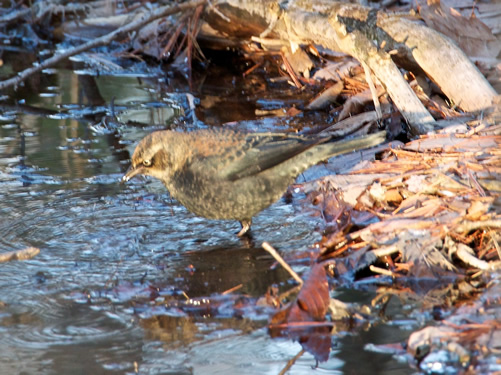
Observer: Paul Lauenstein
Observation Date: 4/28/24
Observation Time: 9:15 a.m.
Observation Location: Moose Hill Audubon Wildlife Sanctuary
Common Name: Savannah Sparrow
Scientific Name: Passerculus sandwichensis
Comments: Savannah sparrows have distinctive yellow eyebrows.
More Information: All About Birds
Observer: Paul Lauenstein
Observation Date: 5/6/15
Observation Time: 3:41 p.m.
Observation Location: soccer field parking lot near Gavins Pond
Common Name: Savannah Sparrow
Scientific Name: Passerculus sandwichensis
Comments: Savannah sparrows are often seen in flocks feeding on the ground.
More Information: All About Birds http://www.allaboutbirds.org/guide/Savannah_Sparrow/sounds
Observer: Paul Lauenstein
Observation Date: 5/1/24
Observation Time: 1:30 p.m.
Observation Location: Moose Hill Audubon Wildlife Sanctuary
Common Name: Scarlet Tanager
Scientific Name: Piranga olivacea
Comments: Scarlet tanagers often unwittingly host eggs of the brown-headed cowbird, particularly where the forest habitat has been fragmented. When a pair of tanagers notices a female cowbird approaching, they aggressively drive her away. However, if the tanagers don’t notice, the cowbird gets rid of a tanager egg and replaces it with one of her own. The tanagers apparently can’t tell the difference, either before or after the egg hatches, and they raise the imposter along with the rest of their brood.
Scarlet tanagers live in the woods, so the best way to find them is to learn their song and listen for them while walking in the woods. The Merlin app can be very helpful with this. Note that only the male is bright red, but the female is drab green.
More Information: All About Birds
Observer: Paul Lauenstein
Observation Date: 5/15/23
Observation Time: 8:50 a.m.
Observation Location: Moose Hill Audubon Wildlife Sanctuary
Common Name: Scarlet Tanager
Scientific Name: Piranga olivacea
Comments: Scarlet tanagers often play host to eggs of the brown-headed cowbird, particularly where the forest habitat has been fragmented. When a pair of tanagers notices a female cowbird approaching, they aggressively drive her away. If the tanagers don’t notice, the cowbird gets rid of a tanager egg and replaces it with one of her own. The tanagers apparently can’t tell the difference, either before or after the egg hatches, and they raise the imposter along with the rest of their brood.
Scarlet tanagers live in the woods, so the best way to find them is to learn their song and listen for them while walking in the woods. Note that only the male is bright red. The female is drab green.
More Information: All About Birds
Observer: Deb Radovsky
Observation Date: 5/15/23
Observation Time: 4:30 p.m.
Observation Location: Moose Hill Audubon Wildlife Sanctuary
Common Name: Scarlet Tanager
Scientific Name: Piranga olivacea
Comments: Scarlet tanagers often play host to eggs of the brown-headed cowbird, particularly where the forest habitat has been fragmented. When a pair of tanagers notices a female cowbird approaching, they aggressively drive her away. If the tanagers don’t notice, the cowbird gets rid of a tanager egg and replaces it with one of her own. The tanagers apparently can’t tell the difference, either before or after the egg hatches, and they raise the imposter along with the rest of their brood.
Scarlet tanagers live in the woods, so the best way to find them is to learn their song and listen for them while walking in the woods. The Merlin app can be very helpful with this. Note that only the male is bright red. The female is drab green.
More Information: All About Birds
Observer: Paul Lauenstein
Observation Date: 5/16/13
Observation Time: 6:15 a.m.
Observation Location: Moose Hill Audubon Wildlife Sanctuary
Common Name: Scarlet tanager
Scientific Name: Piranga olivacea
Comments: Scarlet tanagers live in the woods, so they are seldom seen due to the foliage. However if you learn their call, which sounds like a robin with a sore throat, you can hear them singing and follow your ears until you find them.
They are often found in pairs. The females are as drab as the males are flashy.
More Information: All About Birds
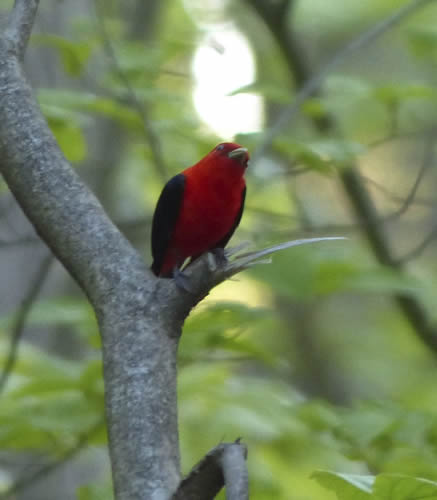
Observer: Paul Lauenstein
Observation Date: 5/16/14
Observation Time: 12:35 p.m.
Observation Location: Moose Hill Audubon Wildlife Sanctuary
Common Name: Scarlet Tanager
Scientific Name: Piranga olivacea
Comments: Scarlet tanagers are common in Sharon, but few people see these brilliantly colored birds because they live in the woods where they are concealed by foliage. If you learn their song, which sounds like a robin with a sore throat, you can find them in wooded areas fairly easily.
More Information: All About Birds
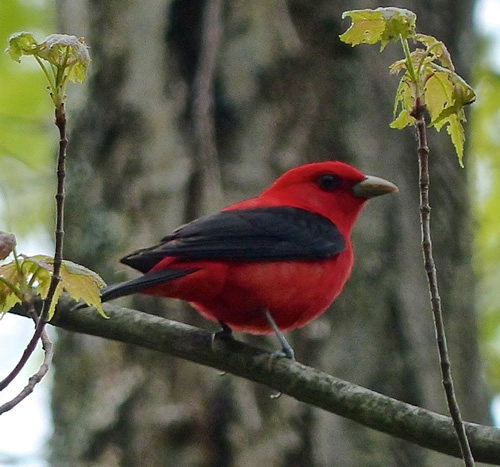
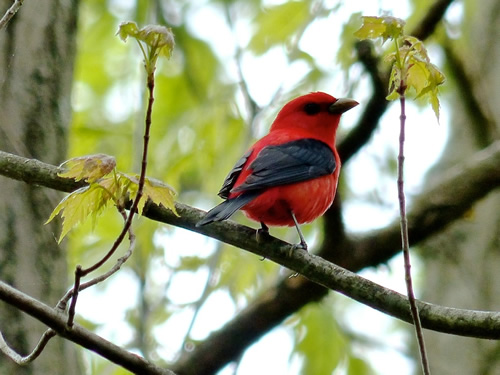
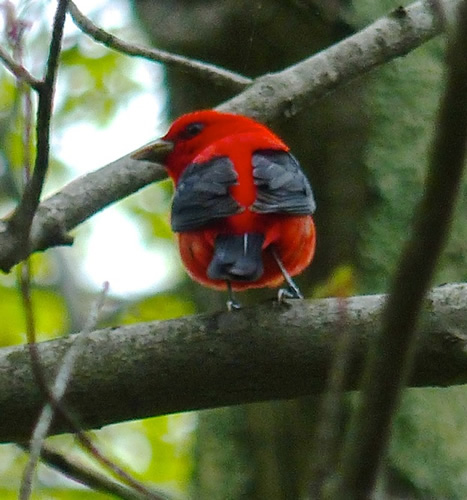
Observer: Paul Lauenstein
Observation Date: 5/23/16
Observation Time: 12:35 p.m.
Observation Location: Moose Hill Audubon Wildlife Sanctuary
Common Name: Scarlet Tanager
Scientific Name: Piranga olivacea
Comments: Scarlet tanagers are common in Sharon, but few people see these brilliantly colored birds because they live in the woods, where they are concealed by foliage. If you learn their song, which sounds like a robin with a sore throat, you can find them in wooded areas fairly easily.
More Information: All About Birds
Observer: Marshall Katler
Observation Date: 5/24/22
Observation Time: 10:15 a.m.
Observation Location: King Phillip Rock where Lakeview Field Trail and Horizon’s path diverge
Common Name: Scarlet Tanager
Scientific Name: Piranga olivacea
Comments: Scarlet tanagers are common in Sharon, but seldom seen. Their woodland habitat obscures them in the leaves. I identified this one by hearing its song. To hear what they sound like, click HERE.
To find them, learn their song and follow your ears as you walk along trails through the woods. Check out the trail maps on this web site.
More Information: All About Birds
Observer: Paul Lauenstein
Observation Date: 5/27/19
Observation Time: 1:10 p.m.
Observation Location: Conservation land near Morse & Lakeview
Common Name: Scarlet Tanager
Scientific Name: Piranga olivacea
Comments: Scarlet tanagers often play host to eggs of the brown-headed cowbird (male and female shown below), particularly where the forest habitat has been fragmented. When a pair of tanagers notices a female cowbird approaching, they aggressively drive her away. If they don’t notice, the cowbird gets rid of a tanager egg and replaces it with one of her own. The tanagers apparently can’t tell the difference, either before or after the egg hatches, and they raise the imposter along with the rest of their brood.
More Information: All About Birds
Observer: Paul Lauenstein
Observation Date: 5/4/23
Observation Time: 7:30 a.m.
Observation Location: Moose Hill Audubon Wildlife Sanctuary
Common Name: Scarlet Tanager
Scientific Name: Piranga olivacea
Comments: Scarlet tanagers often play host to eggs of the brown-headed cowbird, particularly where the forest habitat has been fragmented. When a pair of tanagers notices a female cowbird approaching, they aggressively drive her away. If they don’t notice, the cowbird gets rid of a tanager egg and replaces it with one of her own. The tanagers apparently can’t tell the difference, either before or after the egg hatches, and they raise the imposter along with the rest of their brood.
Scarlet tanagers live in the woods, so the best way to find them is to learn their song and listen for them while walking in the woods. Note that only the male is bright red. The female is drab green.
More Information: All About Birds
Observer: Paul Lauenstein
Observation Date: 5/8/19
Observation Time: 11:10 a.m.
Observation Location: Moose Hill Audubon Wildlife Sanctuary
Common Name: Scarlet Tanager
Scientific Name: Piranga olivacea
Comments: Scarlet tanagers often play host to eggs of the brown-headed cowbird (male and female shown below), particularly where the forest habitat has been fragmented. When a pair of tanagers notices a female cowbird approaching, they aggressively drive her away. If they don’t notice, the cowbird gets rid of a tanager egg and replaces it with one of her own. The tanagers apparently can’t tell the difference, either before or after the egg hatches, and they raise the imposter along with the rest of their brood.
More Information: All About Birds
Observer: Molly DellaRoman
Observation Date: 7/1/13
Observation Time: morning
Observation Location: Trustees of Reservations Moose Hill Farm
Common Name: Scarlet Tanager
Scientific Name: Piranga olivacea
More Information: All About Bird
Observer: Deborah Radovsky
Observation Date: 8/6/20
Observation Time: 7:15 a.m.
Observation Location: Rock Ridge Cemetery
Common Name: Scarlet Tanager
Scientific Name: Piranga olivacea
Comments: Scarlet tanagers are coomon in Sharon, but seldom seen. Their woodland habitat obscures them in the leaves. To find them, learn their song and follow your ears as you wlak along trails through the woods. Check out the trail maps on this web site.
More Information: All About Birds
Observer: Paul Lauenstein
Observation Date: 5/18/23
Observation Time: 9:00 a.m.
Observation Location: Moose Hill Audubon Wildlife Sanctuary
Common Name: Scarlet Tanager (female)
Scientific Name: Piranga olivacea
Comments: Scarlet tanagers are common in Sharon, but few people see these brilliantly colored birds because they live in the woods where they are concealed by foliage. If you learn their song, which sounds like a robin with a sore throat, you can find them in wooded areas fairly easily.
Scarlet tanagers tend to travel in pairs. The males is bright red with jet-black wings. The female is drab greenish yellow with dark wings. I saw this female on the trail gathering nesting materials while the male was singing nearby.
More Information: All About Birds
Observer: Paul Lauenstein
Observation Date: 5/3/18
Observation Time: 10:05 a.m.
Observation Location: Moose Hill Audubon Wildlife Sanctuary
Common Name: Scarlet Tanager (male & female)
Scientific Name: Piranga olivacea
Comments: Scarlet tanagers are common in Sharon, but few people see these brilliantly colored birds because they live in the woods where they are concealed by foliage. If you learn their song, which sounds like a robin with a sore throat, you can find them in wooded areas fairly easily.
Scarlet tanagers tend to travel in pairs. The males is bright red with jet-black wings. The female is drab greenish yellow with gray wings.
More Information: All About Birds
Observer: Deb Radovsky
Observation Date: 5/24/18
Observation Time: 6:15 a.m.
Observation Location: Billings Loop, Moose Hill Audubon Wildlife Sanctuary
Common Name: Scarlet Tanager (male)
Scientific Name: Piranga olivacea
Comments: This scarlet and black woodland bird is common in Sharon but seldom seen because they live in the woods. However, you can find them by learning what their song sounds like.
The female is drab olive-green with dark (but not jet black) wings.
More Information: All About Birds
Observer: Paul Lauenstein
Observation Date: 5/9/19
Observation Time: 6:45 a.m.
Observation Location: Moose Hill Audubon Wildlife Sanctuary
Common Name: Scarlet tanager (orange variant)
Scientific Name: Piranga olivacea
Comments: Male scarlet tanagers are typically bright red with jet black wings (females are drab green). This male, however, was as orange as a Baltimore oriole. Its song was unquestionably that of a scarlet tanager.
More Information: Flickr
Observer: Paul Lauenstein
Observation Date: 5/7/23
Observation Time: 8:45 a.m.
Observation Location: Moose Hill Audubon Wildlife Sanctuary
Common Name: Scarlet Tanager
Scientific Name: Piranga olivacea
Comments: Scarlet tanagers often play host to eggs of the brown-headed cowbird, particularly where the forest habitat has been fragmented. When a pair of tanagers notices a female cowbird approaching, they aggressively drive her away. If they don’t notice, the cowbird gets rid of a tanager egg and replaces it with one of her own. The tanagers apparently can’t tell the difference, either before or after the egg hatches, and they raise the imposter along with the rest of their brood.
Scarlet tanagers live in the woods, so the best way to find them is to learn their song and listen for them while walking in the woods. Note that only the male is bright red. The female is drab green.
More Information: All About Birds
Observer: Richard Kramer
Observation Date: 6/28/11
Observation Time: 11:59 p.m.
Observation Location: Shores of Lake Massapoag
Common Name: Screech Owl (fledgling)
Scientific Name: Otus asio
Comments: Pair of fledglings were calling and testing their wings.
More Information: Cornell Lab of Ornithology “All About Birds”
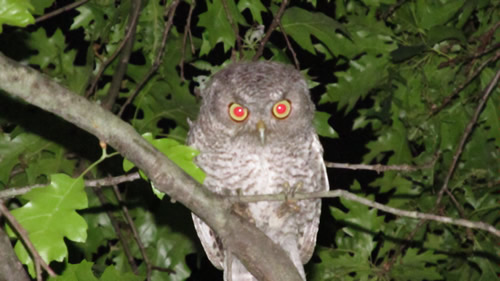
Observer: Paul Lauenstein
Observation Date: 9/18/14
Observation Time: 2:48 p.m.
Observation Place: near Lake Massapoag boat ramp
Common Name: Semipalmated Plover
Scientific Name: Charadrius semipalmatus
Comments: Semipalmated plovers look something like killdeers, but they are smaller and stubbier, and have a single dark band instead of two dark bands like killdeers. Also, killdeers have a red eye ring, whereas semipalmated plovers eyes are black.
More Information: All About Birds
Observer: Josh Simons
Observation Date: 11/20/07
Observation Time: 9:00 a.m.
Observation Location: Moose Hill Parkway
Common Name: Sharp-Shinned Hawk
Scientific Name: Accipiter striatus
Comments: Male is much smaller than the female. The female is about the size and appearance of a Cooper’s hawk. This web page is helpful for distinguishing between these two species of hawks: https://feederwatch.org/learn/tricky-bird-ids/coopers-hawk-and-sharp-shinned-hawk/
More Information: Cornell Lab of Ornithology “All About Birds”
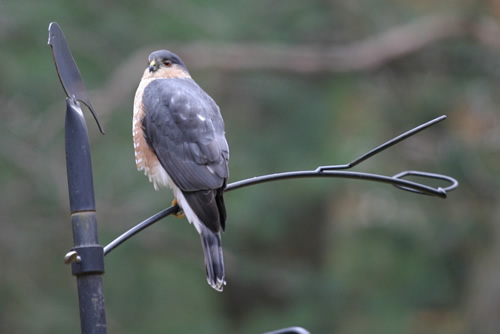
Observer: Josh Simons
Observation Date: 3/28/11
Observation Time: 9:00 a.m.
Observation Location: Moose Hill Parkway
Common Name: Sharp-shinned Hawk
Scientific Name: Accipiter striatus
Comments: Sharp-shinned Hawks are birds of the forest and forest edge, and are not found where trees are scarce or scattered, except on migration. They require dense forest, ideally with a closed canopy, for breeding.
More Information: Cornell Lab of Ornithology “All About Birds”
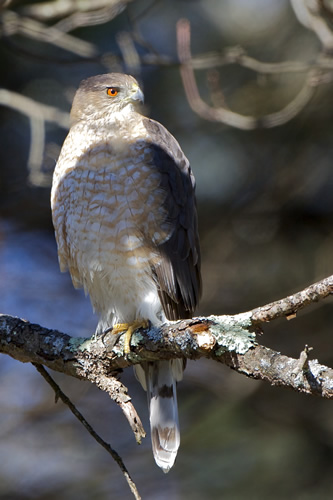
Observer: Paul Lauenstein
Observation Date: 12/26/08
Observation Time: 1:00 p.m.
Observation Location: Dirt road by soccer field near Gavins Pond
Common Name: Snow Bunting
Scientific Name: Plectrophenax nivalis
Comments: Flock of around a dozen birds was gleaning seeds on the dirt road.
More Information: Cornell Lab of Ornithology “All About Birds”
Observer: Paul Lauenstein
Observation Date: 12/12/08
Observation Time: 10:00 a.m.
Observation Location: Ward’s field near Heights Elementary School
Common Name: Snow Goose
Scientific Name: Chen caerulescens
Comments: There was a flock of about 10 snow geese in Ward’s field. They were all white except for black wing tips.
More Information: Cornell Lab of Ornithology “All About Birds”
Observer: Josh Simons
Observation Date: 2/10/14
Observation Time: 5:00 p.m.
Observation Location: Moose Hill area
Common Name: Song Sparrow
Scientific Name: Melospiza melodia
Comments: Melos meaning “song”, “spiza” meaning “a finch” and “melodia” meaning “a pleasant sound”. “Sparrow” comes from the Anglo-Saxon “spearwa” or “sparrow”, literally “flutterer”. [The Dictionary of American Bird Names by Ernest A. Choate]
More Information: Cornell Lab of Ornithology “All About Birds”
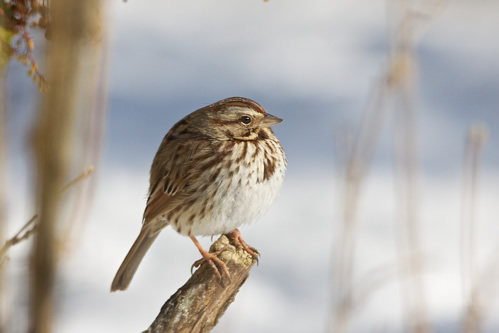
Observer: Paul Lauenstein
Observation Date: 4/23/24
Observation Time: 9:45 a.m.
Observation Location: Moose Hill Audubon Wildlife Sanctuary
Common Name: Song Sparrow
Scientific Name: Melospiza melodia
Comments: Song sparrows have a distinctive dark spot on their breast. This individual seems to have injured one of its left toes.
There are at least 18 species of sparrows in Massachusetts. Learning their respective calls is a good way to find and identify them. Or simply use a free cell phone app called Merlin.
More Information: All About Birds
Observer: Paul Lauenstein
Observation Date: 4/7/11
Observation Time: 5:40 p.m.
Observation Location: Gavins Pond Road near soccer fields
Common Name: Song Sparrow
Scientific Name: Melospiza melodia
Comments: This song sparrow was gleaning seeds. Their distinctive, melodious song is a good one to memorize because it is so common.
More Information: Cornell Lab of Ornithology “All About Birds”
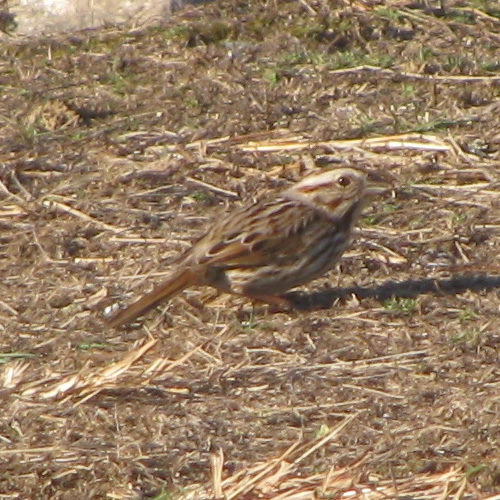
Observer: Paul Lauenstein
Observation Date: 5/29/16
Observation Time: 1:50 p.m.
Observation Location: near Lake Massapoag boat ramp
Common Name: Song Sparrow
Scientific Name: Melospiza melodia
Comments: There are at least 18 species of sparrows in Massachusetts. Learning their respective calls is a good way to find and identify them. The spot on its chest also helps with identification.
More Information: All About Birds
Observer: Paul Lauenstein
Observation Date: 5/29/14
Observation Time: 11:25 a.m.
Observation Location: Borderland State Park
Common Name: Song Sparrow
Scientific Name: Melospiza melodia
Comments: There are at least 18 species of sparrows in Massachusetts. Learning their respective calls is a good way to find and identify them.
More Information: All About Birds
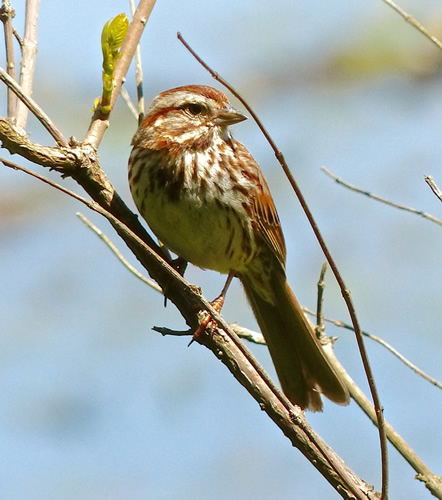
Observer: Paul Lauenstein
Observation Date: 5/31/20
Observation Time: 4:50 p.m.
Observation Location: Trustees of Reservations’ Moose Hill Farm
Common Name: Song Sparrow
Scientific Name: Melospiza melodia
Comments: There are at least 18 species of sparrows in Massachusetts. Learning their respective calls is a good way to find and identify them.
More Information: All About Birds
Observer: Paul Lauenstein
Observation Date: 6/2/19
Observation Time: 3:45 p.m.
Observation Location: in the wetlands beneath the power lines across the street from Ward’s Berry Farm
Common Name: Song Sparrow
Scientific Name: Melospiza melodia
Comments: There are at least 18 species of sparrows in Massachusetts. Learning their respective calls is a good way to find and identify them.
More Information: All About Birds
Observer: Deb Radovsky
Observation Date: 5/12/18
Observation Time: 7:30 a.m.
Observation Location: Lake Massapoag
Common Name: Spotted Sandpiper
Scientific Name: Actitis macularius
Comments: The Spotted Sandpiper is the most widespread breeding sandpiper in North America. Female Spotted Sandpipers sometimes practice an unusual breeding strategy called polyandry, where a female mates with up to four males, each of which then cares for a clutch of eggs.
More Information: All About Birds
Observer: Paul Lauenstein
Observation Date: 7/31/10
Observation Time: 11:15 a.m.
Observation Location: Gavins Pond outflow pool
Common Name: Spotted Sandpiper
Scientific Name: Actitis macularia
Comments: Though you may think of the beach as the best place to see a sandpiper, look for Spotted Sandpipers alone or in pairs along the shores of lakes, rivers, and streams.
More Information: All About Birds
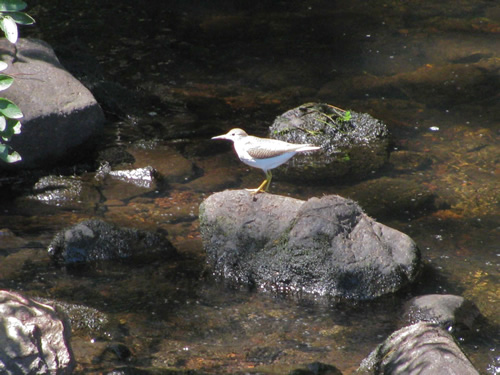
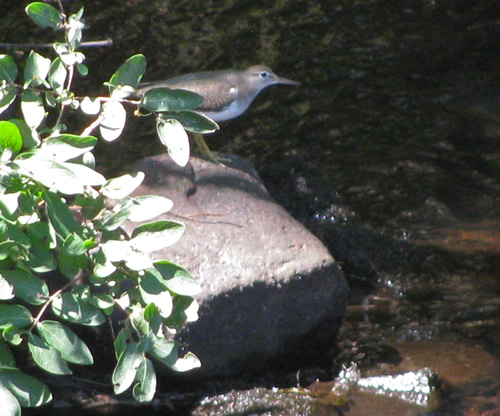
Observer: Deborah Radovsky
Observation Date: 8/6/20
Observation Time: 7:00 a.m.
Observation Location: Lake Massapoag
Common Name: Spotted Sandpiper
Scientific Name: Actitis macularius
Comments: The Spotted Sandpiper is the most widespread breeding sandpiper in North America. Female Spotted Sandpipers sometimes practice an unusual breeding strategy called polyandry, where a female mates with up to four males, each of which then cares for a clutch of eggs.
More Information: All About Birds
Observer: Paul Lauenstein
Observation Date: 5/27/19
Observation Time: 9:35 a.m.
Observation Location: Conservation land near Morse & Lakeview
Common Name: Swainson’s Thrush
Scientific Name: Catharus ustulatus
Comments: I lucked into this one. As I was walking down a trail through the woods I saw it fly from the trail up to a nearby branch, and I got just one photo before it flew away. I assumed it was a hermit thrush, but a friend studied the photo and told me it’s a Swainson’s. I had never seen one before.
More Information: All About Birds
Observer: Paul Lauenstein
Observation Date: 4/26/23
Observation Time: 6:25 a.m.
Observation Location: Moose Hill Audubon Wildlife Sanctuary (boardwalk)
Common Name: Swamp Sparrow
Scientific Name: Melospiza georgiana
Comments: The Swamp Sparrow has longer legs than other sparrows, which allows it to wade in shallow water to forage.
More Information: All About Birds
Observer: Paul Lauenstein
Observation Date: 5/17/15
Observation Time: 7:45 a.m.
Observation Location: Moose Hill Audubon Wildlife Sanctuary
Common Name: Tennessee Warbler
Scientific Name: Leiothlypis peregrina
Comments: This bird was flitting around in a flowering crabapple tree.
More Information: All About Birds
Observer: Daniel O’Brien
Observation Date: 5/20/23
Observation Time: 8:30 a.m.
Observation Location: Moose Hill Audubon Wildlife Sanctuary
Common Name: Tennessee Warbler
Scientific Name: Leiothlypis peregrina
Comments: This warbler was spotted in a tree near the giant sugar maples known as George & Martha.
More Information: All About Birds
Observer: Paul Lauenstein
Observation Date: 4/23/24
Observation Time: 7:30 am
Observation Location: Moose Hill Audubon Wildlife Sanctuary
Common Name: Tree Swallow
Scientific Name: Tachycineta bicolor
Comments: Tree swallows compete with bluebirds for nesting boxes.
More Information: All About Birds
Observer: Paul Lauenstein
Observation Date: 4/25/23
Observation Time: 8:51 am
Observation Location: Moose Hill Audubon Wildlife Sanctuary
Common Name: Tree Swallow
Scientific Name: Tachycineta bicolor
Comments: Tree swallows compete with bluebirds for nesting boxes.
More Information: All About Birds
Observer: Kurt Buermann
Observation Date: 5/12/11
Observation Time: 1:30 p.m.
Observation Location: Laveview Street meadow
Common Name: Tree swallow
Scientific Name: Tachycineta bicolor
Comments: Very commonly nests near bluebirds. Tree swallows may defend bluebirds against other tree swallow if they occupy adjacent nesting boxes.
More Information: All About Birds.org
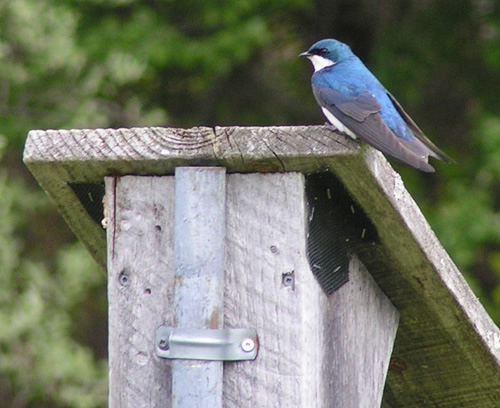
Observer: Deb Radovsky
Observation Date: 5/18/16
Observation Time: N/A
Observation Location: Moose Hill area
Common Name: Tree Swallow
Scientific Name: Tachycineta bicolor
Comments: Tree swallows compete with bluebirds for nesting boxes.
More Information: All About Birds
Observer: Paul Lauenstein
Observation Date: 5/30/10
Observation Time: 4:35 p.m.
Observation Location: field near Gavins Pond
Common Name: Tree swallow
Scientific Name: Tachycineta bicolor
Comments: Tree swallows nest in bluebird nesting boxes. One strategy is to locate two bluebird houses within 10 yards of each other. Tree swallows nesting in one box will drive other tree swallows away from the other box, but allow bluebirds to move in.
More Information: All About Birds.org
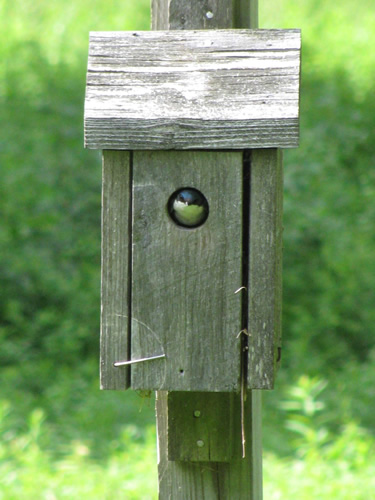
Observer: Paul Lauenstein
Observation Date: 5/4/11
Observation Time: 1:00 p.m.
Observation Location: near Gavins Pond Dam
Common Name: Tree swallow
Scientific Name: Tachycineta bicolor
Comments: Tree swallows compete for bluebird nesting boxes. Bluebird house are often set out in pairs. One box gets taken by a pair of tree swallows. They drive other tree swallows away from the other box, but allow bluebirds to move in.
More Information: All About Birds.org

Observer: Paul Lauenstein
Observation Date: 5/5/23
Observation Time: 6:50 am
Observation Location: Moose Hill Audubon Wildlife Sanctuary
Common Name: Tree Swallow
Scientific Name: Tachycineta bicolor
Comments: Tree swallows compete with bluebirds for nesting boxes. This pair was sitting on the post of a nesting box.
More Information: All About Birds
Observer: Paul Lauenstein
Observation Date: 5/8/14
Observation Time: 7:10 a.m.
Observation Location: Moose Hill Audubon Wildlife Sanctuary
Common Name: Tree swallow
Scientific Name: Tachycineta bicolor
Comments: Tree swallows compete with bluebirds for nesting boxes. However, if nesting boxes are sited in pairs, a tree swallow will occupy one box and drive away other tree swallows from the other box. That will allow bluebirds to nest there.
More Information: All About Birds.org
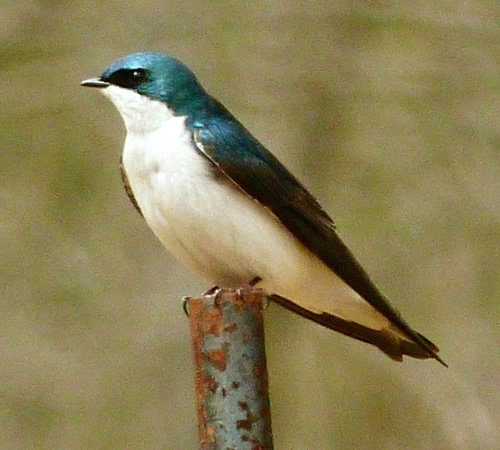
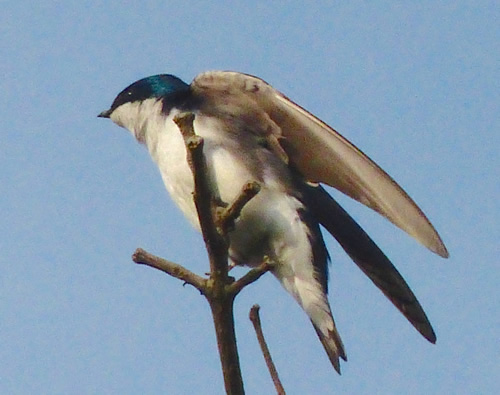
Observer: Paul Lauenstein
Observation Date: 4/25/24
Observation Time: 9:15 am
Observation Location: Moose Hill Audubon Wildlife Sanctuary
Common Name: Tree Swallow
Scientific Name: Tachycineta bicolor
Comments: Tree swallows compete with bluebirds for nesting boxes.
More Information: All About Birds
Observer: Josh Simons
Observation Date: 1/1/09
Observation Time: 2:00 p.m.
Observation Location: Moose Hill Parkway
Common Name: Tufted Titmouse
Scientific Name: Baeolophus bicolor
Comments: This and the junco and wren photos were all taken with a Canon 50D and a Canon 500mm f4 lens from the comfort of my kitchen on Moose Hill Parkway. We have feeders that attract lots of birds who land on a nearby lilac bush while waiting for their turn at the feeders.
In terms of processing, I use very little. The images are cropped and very small
adjustments are made to exposure and contrast with sometimes a little extra
sharpening applied.
That and the nice, slanting winter sunlight are all there is to it.
More Information: Cornell Lab of Ornithology “All About Birds”
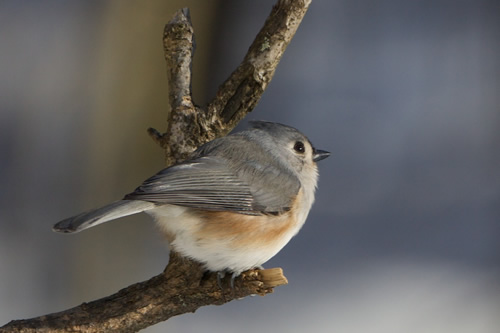
Observer: Paul Lauenstein
Observation Date: 11/27/20
Observation Time: 12:20 p.m.
Observation Location: Gavins Pond Rd. (my back yard)
Common Name: Tufted Titmouse
Scientific Name: Baeolophus bicolor
Comments: Tufted titmice are abundant in Sharon. They are often encountered in the company of chickadees.
More Information: All About Birds
Observer: Paul Lauenstein
Observation Date: 2/25/20
Observation Time: 12:50 p.m.
Observation Location: Moose Hill Audbon Wildlife Sanctuary
Common Name: Tufted Titmouse
Scientific Name: Baeolophus bicolor
Comments: This tufted titmouse was feeding at the bird feeder by the Moose Hill Audubon headquarters.
More Information: All About Birds
Observer: Paul Lauenstein
Observation Date: 4/15/20
Observation Time: 1:15 p.m.
Observation Location: Conservation land near Sandy Ridge Circle
Common Name: Tufted Titmouse
Scientific Name: Baeolophus bicolor
Comments: Tufted titmice are abundant in the woods in Sharon. They are often encountered in the company of chickadees.
More Information: All About Birds
Observer: Paul Lauenstein
Observation Date: 5/1/18
Observation Time: 9:00 a.m.
Observation Location: Moose Hill Audbon Wildlife Sanctuary
Common Name: Tufted Titmouse
Scientific Name: Baeolophus bicolor
Comments: Often seen in the company of chickadees.
More Information: All About Birds
Observer: Paul Lauenstein
Observation Date: 5/16/23
Observation Time: 7:50 a.m.
Observation Location: Moose Hill Audubon Wildlife Sanctuary
Common Name: Tufted Titmouse
Scientific Name: Baeolophus bicolor
Comments: Tufted titmice are abundant in the woods in Sharon. They are often encountered in the company of chickadees. This one had caught a caterpillar.
More Information: All About Birds
Observer: Paul Lauenstein
Observation Date: 5/2/20
Observation Time: 12:50 p.m.
Observation Location: 4 Gavins Pond Road (in my back yard)
Common Name: Tufted Titmouse
Scientific Name: Baeolophus bicolor
Comments: Tufted titmice are abundant in the woods in Sharon. They are often encountered in the company of chickadees.
More Information: All About Birds
Observer: Paul Lauenstein
Observation Date: 4/11/11
Observation Time: 6:10 p.m.
Observation Location: Gavins Pond
Common Name: Turkey Vulture
Scientific Name: Cathartes aura
Comments: Turkey vultures are gliders. They ride thermal updrafts, so they rarely need to flap their wings.
More Information: All About Birds
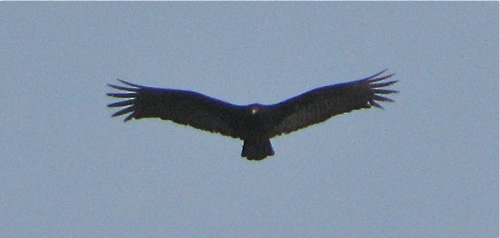
Observer: Paul Lauenstein
Observation Date: 4/20/20
Observation Time: 9:10 a.m.
Observation Location: conservation land near Lakeview & Morse
Common Name: Turkey Vulture
Scientific Name: Cathartes aura
Comments: Turkey vultures are gliders. They ride thermal updrafts, so they rarely need to flap their wings.
More Information: All About Birds
Observer: Rick Dumont
Observation Date: 7/28/09
Observation Time: 2:00 p.m.
Observation Location: Belcher Street
Common Name: Turkey Vulture
Scientific Name: Cathartes aura
Comments: A bad smell invaded my yard during a rainy, humid spell. The buzzard must have been attracted to it. The smell went away shortly after the buzzard did.
More Information: All About Birds
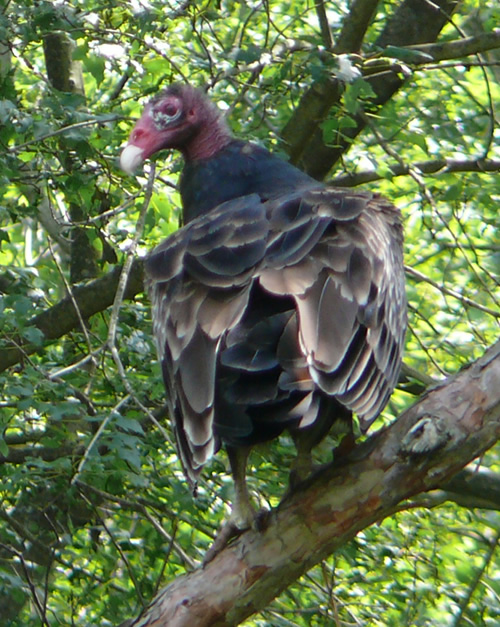
Observer: Paul Lauenstein
Observation Date: 5/15/15
Observation Time: 10:35 a.m.
Observation Location: Moose Hill Audubon Wildlife Sanctuary
Common Name: Veery
Scientific Name: Catharus fuscescens
Comments: A veery is a woodland thrush with an ethereal call, which if played back in slow motion reveals that the bird is actually mingling two calls simultaneously, like a violin player bowing two strings at once. I think of the veery’s two strands of downward-cascading sound as a double-helix. Hear it at: http://earbirding.com/blog/archives/3711
More Information: All About Birds
Observer: Paul Lauenstein
Observation Date: 5/15/23
Observation Time: 9:00 a.m.
Observation Location: Moose Hill Audubon Wildlife Sanctuary (boardwalk)
Common Name: Veery
Scientific Name: Catharus fuscescens
Comments: Check out the veery’s ethereal song at: https://www.youtube.com/watch?v=cK1gaTqBRRk
More Information: All About Birds
Observer: Paul Lauenstein
Observation Date: 5/16/23
Observation Time: 9:15 a.m.
Observation Location: Moose Hill Audubon Wildlife Sanctuary
Common Name: Veery
Scientific Name: Catharus fuscescens
Comments: Check out the veery’s ethereal song at: https://www.youtube.com/watch?v=cK1gaTqBRRk
More Information: All About Birds
Observer: Deb Radovsky
Observation Date: 5/18/18
Observation Time: 6:00 p.m.
Observation Location: Moose Hill, Billings Loop
Common Name: Veery
Scientific Name: Catharus fuscescens
Comments: Check out the veery’s ethereal song at: https://www.youtube.com/watch?v=cK1gaTqBRRk
More Information: All About Birds
Observer: Josh Simons
Observation Date: 5/18/23
Observation Time: 2:40 p.m.
Observation Location: Moose Hill Audubon Wildlife Sanctuary (intersection of Deer and Kettle trails)
Common Name: Veery
Scientific Name: Catharus fuscescens
Comments: Check out the veery’s ethereal song at: https://www.youtube.com/watch?v=cK1gaTqBRRk
More Information: All About Birds
Observer: Deb Radovsky
Observation Date: 5/2/22
Observation Time: early morning
Observation Location: Moose Hill Audubon Wildlife Sanctuary boardwalk
Common Name: Veery
Scientific Name: Catharus fuscescens
Comments: Check out the veery’s ethereal song at: https://www.youtube.com/watch?v=cK1gaTqBRRk
More Information: All About Birds
Observer: Paul Lauenstein
Observation Date: 5/22/18
Observation Time: 9:50 a.m.
Observation Location: woods near Beaver Brook
Common Name: Veery
Scientific Name: Catharus fuscescens
Comments: A veery is a woodland thrush with an ethereal call, which if played back in slow motion reveals that the bird is actually mingling two calls simultaneously, like a violin player bowing two strings at once. I think of the veery’s two strands of downward-cascading sound as a double-helix. Hear it at: http://earbirding.com/blog/archives/3711
More Information: All About Birds
Observer: Jason Platt
Observation Date: 5/8/18
Observation Time: 10:30 a.m.
Observation Location: Moose Hill Audubon Wildlife Sanctuary
Common Name: Veery
Scientific Name: Catharus fuscescens
Comments: A veery is a woodland thrush with an ethereal call, which if played back in slow motion reveals that the bird is actually mingling two calls simultaneously, like a violin player bowing two strings at once. I think of the veery’s two strands of downward-cascading sound as a double-helix. Hear it at: http://earbirding.com/blog/archives/3711
More Information: All About Birds
Observer: Paul Lauenstein
Observation Date: 5/21/14
Observation Time: 4:40 p.m.
Observation Location: Gavins Pond
Common Name: Warbling vireo
Scientific Name: Vireo gilvus
Comments: Warbling vireos are usually found near water.
More Information: All About Birds
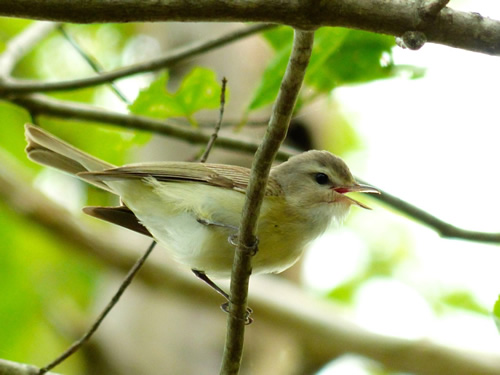
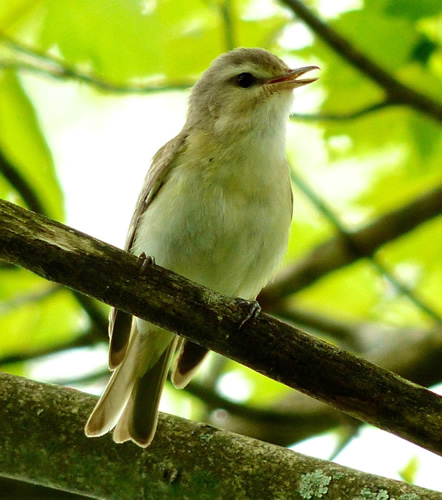
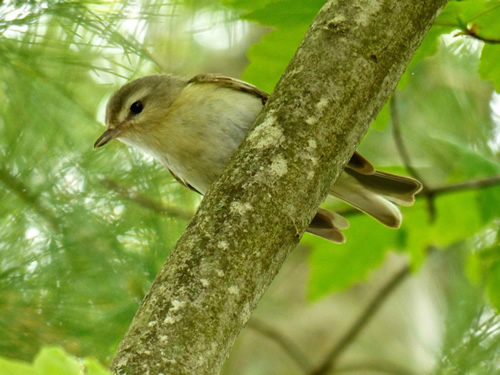
Observer: Paul Lauenstein
Observation Date: 5/6/15
Observation Time: 3:38 p.m.
Observation Location: near Gavins Pond
Common Name: Warbling Vireo
Scientific Name: Vireo gilvus
Comments: Warbling vireos are often found near water.
More Information: All About Birds
Observer: Paul Lauenstein
Observation Date: 3/8/14
Observation Time: 11:00 a.m.
Observation Location: Moose Hill Audubon Wildlife Sanctuary
Common Name: White-breasted nuthatch
Scientific Name: Sitta carolinensis
Comments: This white-breasted nuthatch was attracted to the suet feeder at Moose Hill Audubon Wildlife Sanctuary headquarters.
More Information: All About Birds: White-breasted Nuthatch
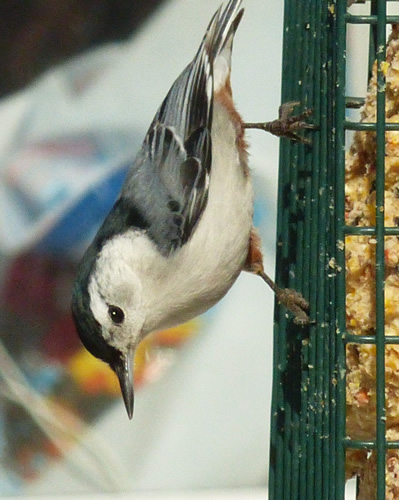
Observer: Josh Simons
Observation Date: 5/10/20
Observation Time: 1:15 p.m.
Observation Location: Moose Hill area
Common Name: White-breasted nuthatch
Scientific Name: Sitta carolinensis
Comments: White-breasted nuthatches are year-round Sharon residents. Learn to identify their nasal call.
More Information: All About Birds: White-breasted Nuthatch

